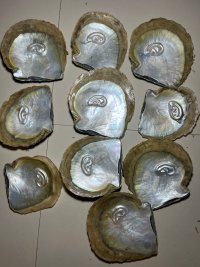Hello everyone, im new to these forums and I hope this is the right place to ask.
I'm an artist and I want to try working with pearls, specifically I want to create my own cultures pearls made with unique pearl nuclei. But when I Google about what materials oysters can create pearls around I can only find that it has to be organic and that cultured pearls are often made from a piece of mantle or mussel.
The original process that gives us pearls was to get rid of parasites if I did my research right, so would bodily materials work as a pearl nucleus? Things like feathers, hair, bone, etc?
I also had a question about how decomposition works for those parasites encased in nacre, and how the structural integrity of the (beginning) pearl doesn't collapse as soon as it starts to decompose.
I hope someone can answer my questions, and thanks so much for taking a look.
The first cultured pearls were made with silver and gold beads - they quickly switched to shell so they could have something that was equally hard as the pearl itself so the pearl is can be drilled. The pearl core doesn’t need to be an organic material, it just needs to have a bit of oyster mantle next to it
We know a little about how decomposition works with natural blister pearls - basically, the attacking organism (if it is an organism and not a broken part of the oysters own shell) was smothered by layers of nacre. The body of the attacker remains mostly intact unless exposed to air, which happened when the shell is being processed by humans. When exposed to air, organic decay sets in. Humans turning the blister pearl into jewelry would clean out the smelly dead attacker, fill the pearl with a stabilizing material, and then a mother of pearl cap was attached to the exposed back.
Chinese freshwater pearls farmers often experiment with pearls. They did develop a pearl with a “earthen material” core (soufflé pearls) which could be drilled and are surprisingly strong. When drilled, they do need to be cleaned very thoroughly, or they can smell foul. The little h geode pearls are made out of soufflés, if you’re wondering what they look like - you can do a google search, or look at some of the Pearls in Action.
So, as long as the core is softer than a pearl, unique core materials possibly can be used, especially on a second graft. If you are thinking of having pearls cultured with a unique core, there are a few things you should keep in mind.
1) Oysters are here for a good time, not a long time. They live longer on pearl farms than in the wild, but even with a dedicated team of 10-50 people who check on them regularly, fight off the ocean creatures who would eat them, and scrub bacteria and pests off their shells, over half the oysters die on a pearl farm without producing a pearl.
2) Producing a pearl requires highly specialized staff. It would be more accurate if pearl technicians were called Pearl surgeons - it’s that precise and delicate an operation, and its done with the best of care and attention to the oyster.
3) It takes about a year to three years to raise an oyster until it can produce a pearl (depending on the species.) It then takes about two years to produce a cultured pearl. Pearls have been pulled as early as 6 months, but those 6 month pearls became brittle and worthless, with their nacre drying out and brittle while sitting under the lights of a showcase.
4) A natural disaster can destroy a pearl farm. And that’s not all - Mollusks are the oceans’s water filtration system - too much pollution will kill them. Weird algae, stupid boaters, too much river runoff affecting the salinity of the water - any of them can and does wipe out oyster populations.
5) Demand for top quality pearls outstrips the supply. Very few pearl farms would be interested in an experimental commission.
Which is why you would be looking at a USD five to seven figure investment to convince a pearl farm to experiment on your idea - and with bad luck, you might never see a single pearl even after all that.
There are some unique and beautiful pearls out there, some of which have unique cores, great shapes, or stunning nacre. Unless you have the money and obsessive need and love and passion - or a Damian Hirst level consortium behind you - you might be better off finding an existing pearl that speaks to your vision

